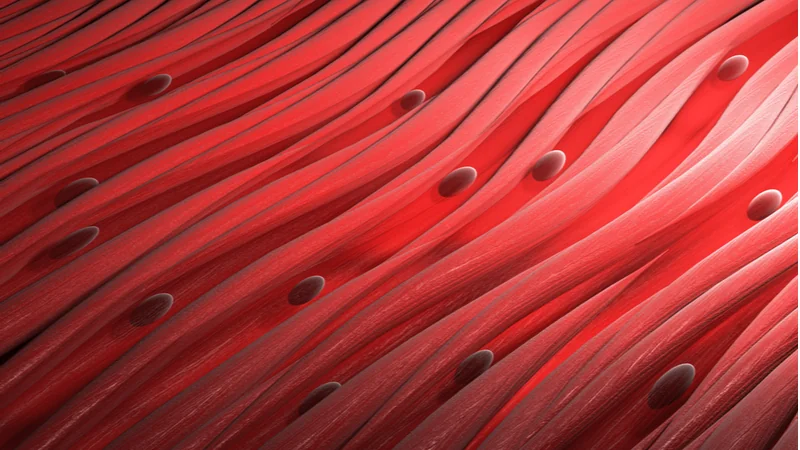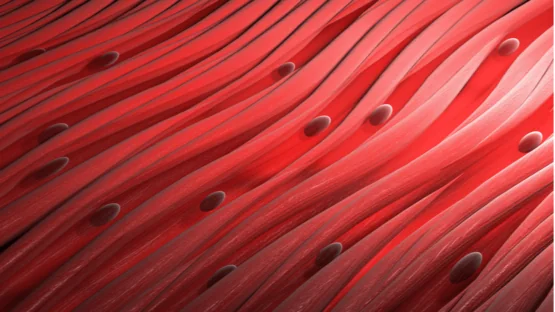A paper published in Cell Stem Cell has detailed how mitochondrial division is critical to the ability of muscle stem cells to regenerate damaged tissue [1].
Waiting until needed
This paper begins with a discussion of quiescent muscle stem cells, which are held in reserve until injury causes them to form new somatic muscle cells, restoring fibers and tissue function. This shift from quiescence to proliferation deteriorates with aging [2].
Part of the maintenance of muscle stem cells involves these cells consuming their own components (organelles) in a process called autophagy [3]. In the absence of regular and consistent autophagy, cells begin to accumulate damaged organelles, which also occurs with aging and may be responsible for the deterioration of muscle stem cells [2].
Mitochondria naturally combine with one another (fusion) and divide (fission) within cells. Previous research has found that this process naturally contributes to autophagy by sequestering damaged mitochondria and making them easier to consume and destroy [4]. However, a causal link between this process and muscle stem cell function had not yet been determined, which is the purpose of this paper.
Examining gene expression
The researchers began their experiments by conducting gene expression analyses on muscle stem cells taken from uninjured and injured mice. Of course, pathways relating to cellular division were strongly upregulated in the cells taken one and three days after injury, as were pathways regulating the generation of energy.
What the researchers found particularly interesting, however, was the upregulation of Drp1, a gene that was even more upregulated than cellular growth. This gene is associated with mitochondrial fission. The physical transition matched this upregulation; while quiescent stem cells had only small mitochondria, these mitochondria grew to medium and large sizes one day after injury, and three days after injury, the mitochondria were small again, suggesting rapid growth and division.
Proving its necessity
To determine how much Drp1 and mitochondrial fission are necessary for stem cell proliferation, the researchers created a strain of mice that are impaired in Drp1 expression. While there were few differences and little evidence of dysfunction while their stem cells were quiescent, proliferation after injury led to abnormalities in these altered mice.
Compared to controls, the muscle stem cells of these mice had abnormally elongated, dysfunctional mitochondria that had more reactive oxygen species (ROS) and failed to transition towards oxidative phosphorlyation, an energetic mode of respiration. Their gene expression showed less proliferation as well. At the macro level, these mice had smaller muscle fibers, even two weeks after injury.
Mitochondrial recycling through autophagy (mitophagy) was also found to be impaired in the modified mice. While the Parkin signal for mitophagy was substantially upregulated, that signal was not being properly taken up by the impaired mitochondria, which was likely to be why Parkin was accumulating in the cytoplasm instead.
Developing treatment strategies
The researchers then experimented to see if hampering mitochondrial fusion through silencing the relevant RNA would have any effects on the mitochondrial fission-impaired cells. While this somewhat normalized mitochondria in these cells and increased their proliferative capacity and ability to form muscle fibers, it harmed cells taken from wild-type mice in this respect.
Restoring oxidative phosphorylation through dichloroacetate and promoting autophagy through rapamycin were also helpful in restoring these cells’ proliferative abilities. Most importantly, this approach was also found to be beneficial for muscle stem cells taken from aged wild-type mice, improving their proliferative and regenerative abilities. The researchers noted that old cells have more problems than the Drp1-impaired cells of modified young animals, such as inflammation.
Conclusion
This research puts together the two aging hallmarks of mitochondrial dysfunction and stem cell exhaustion, showing how they are tied together in a very specific way. This is the first research of its kind that seeks a solution to a generally unknown but significant problem. If mitochondria in muscle stem cells can be safely affected in human beings through small molecule treatments, this research might lead to at least a partial treatment for the age-related muscle loss known as sarcopenia.
Literature
[1] Hong, X., Isern, J., Campanario, S., Perdiguero, E., Ramírez-Pardo, I., Segalés, J., … & Muñoz-Cánoves, P. (2022). Mitochondrial dynamics maintain muscle stem cell regenerative competence throughout adult life by regulating metabolism and mitophagy. Cell Stem Cell.
[2] Sousa-Victor, P., Neves, J., & Muñoz-Cánoves, P. (2020). Muscle stem cell aging: identifying ways to induce tissue rejuvenation. Mechanisms of Ageing and Development, 188, 111246.
[3] García-Prat, L., Martínez-Vicente, M., Perdiguero, E., Ortet, L., Rodríguez-Ubreva, J., Rebollo, E., … & Muñoz-Cánoves, P. (2016). Autophagy maintains stemness by preventing senescence. Nature, 529(7584), 37-42.
[4] Twig, G., Elorza, A., Molina, A. J., Mohamed, H., Wikstrom, J. D., Walzer, G., … & Shirihai, O. S. (2008). Fission and selective fusion govern mitochondrial segregation and elimination by autophagy. The EMBO journal, 27(2), 433-446.





